Understanding Quadriceps Tendonitis
Quadriceps tendonitis is inflammation of the tendon connecting the quadriceps muscle to the kneecap, causing pain and affecting mobility․ Understanding its causes aids in successful management․
1․1 Definition and Overview
Quadriceps tendonitis is an inflammatory condition affecting the tendon that connects the quadriceps muscle to the patella (kneecap)․ It often results from overuse, repetitive stress, or muscle imbalances, leading to pain and swelling just above the knee․ The quadriceps muscle is crucial for knee extension and straightening, making this condition disruptive to daily activities and sports․ Symptoms typically include pain during activities like jumping, running, or climbing stairs, as well as tenderness and swelling around the kneecap․ Early diagnosis and treatment are essential to prevent progression and promote recovery․ This condition is common among athletes and individuals with repetitive knee stress, emphasizing the need for proper management and rehabilitation strategies․
1․2 Common Causes and Risk Factors
Quadriceps tendonitis often arises from overuse, repetitive stress, or sudden increases in physical activity․ Activities involving frequent jumping, running, or quick changes of direction are common contributors․ Muscle imbalances, such as weak hamstrings or tight hip flexors, can also strain the quadriceps tendon․ Poor training techniques, inadequate warm-ups, or improper footwear may exacerbate the risk․ Individuals with pre-existing knee conditions or those engaging in sports like basketball, soccer, or cycling are more prone to this condition․ Additionally, age-related wear and tear can weaken the tendon, making it more susceptible to injury․ Understanding these causes and risk factors is crucial for developing effective prevention and treatment strategies․
1․3 Symptoms and Diagnosis
The primary symptom of quadriceps tendonitis is pain above the kneecap, often worsening with activities like jumping, climbing stairs, or straightening the leg․ Swelling, warmth, or tenderness around the knee may also occur․ Weakness or instability in the knee can make everyday movements challenging․ Diagnosis typically begins with a physical examination, assessing pain location, swelling, and range of motion․ Physicians may perform tests like the straight leg raise to evaluate strength and discomfort․ Imaging, such as X-rays or MRIs, may be used to confirm the diagnosis and rule out other conditions like tendon ruptures or arthritis․ Early detection is crucial for effective treatment and preventing further damage․
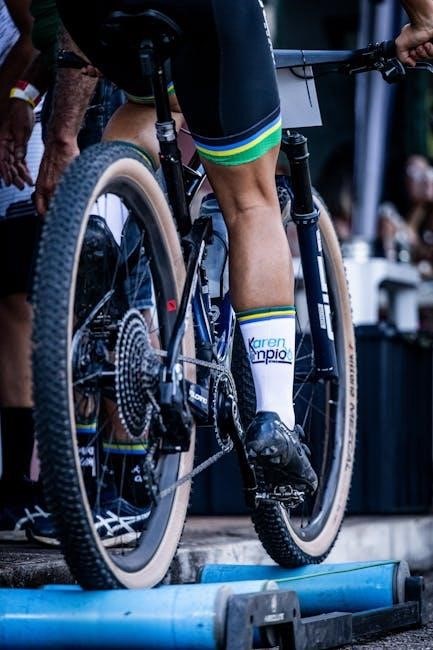
Initial Treatment and Management
Initial treatment includes the PRICE principle, NSAIDs for pain relief, activity modification, rest, and immobilization to reduce stress and promote healing effectively․
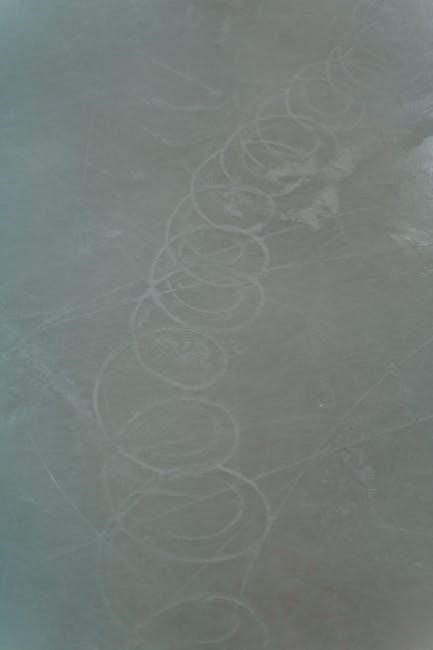
2․1 PRICE Principle (Protection, Rest, Ice, Compression, Elevation)
The PRICE principle is a cornerstone of early treatment for quadriceps tendonitis; Protection involves avoiding activities that exacerbate pain or stress the tendon․ Rest allows the tendon to heal without further strain․ Applying ice for 15–20 minutes every 1–2 hours helps reduce inflammation and pain․ Compression with an elastic bandage or sleeve provides support and limits swelling․ Finally, elevation of the affected leg above heart level reduces swelling․ This principle is most effective in the first 48–72 hours post-injury and creates an optimal environment for healing․ Adhering to PRICE minimizes damage and accelerates recovery, making it a critical first step in managing quadriceps tendonitis effectively․
2․2 Pain Management Strategies
Effective pain management is crucial for alleviating discomfort and promoting recovery in quadriceps tendonitis․ Over-the-counter nonsteroidal anti-inflammatory drugs (NSAIDs), such as ibuprofen or naproxen, can help reduce inflammation and pain․ Topical creams or gels containing NSAIDs may also provide localized relief․ In addition to the PRICE principle, incorporating gentle stretching and low-impact exercises can improve mobility without exacerbating pain․ Compression sleeves or braces may offer additional support and stability․ In some cases, physical therapy or acupuncture can complement traditional treatments․ It’s essential to avoid activities that worsen pain and consult a healthcare provider before starting any new pain management regimen, especially if considering prescription medications․
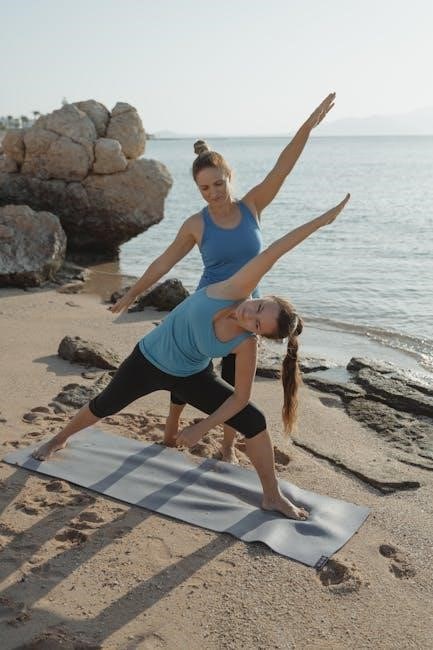
Exercise Phases for Rehabilitation
A structured approach focusing on pain management, improving mobility, and restoring strength through progressive exercises tailored to each recovery stage․
3․1 Phase 1: Pain Management and Isometric Exercises
This initial phase focuses on reducing pain and inflammation while maintaining muscle strength through low-impact exercises․ Isometric exercises, such as quadriceps sets and straight leg raises, are prioritized to avoid putting additional strain on the tendon․ These exercises help improve muscle activation without joint movement, reducing the risk of further injury․ Patients are also encouraged to use the PRICE principle (Protection, Rest, Ice, Compression, Elevation) to manage symptoms․ Gentle stretching and mobility exercises may be introduced as pain subsides․ The goal is to create a foundation for recovery by balancing rest and controlled activation of the quadriceps muscles․ Progression to later phases is dependent on pain reduction and improved function․
3․2 Phase 2: Active Range of Motion (AROM) and Gentle Strengthening
Phase 2 focuses on gradually increasing knee mobility and introducing gentle strengthening exercises once pain and inflammation are controlled․ Active Range of Motion (AROM) exercises, such as heel slides, wall-assisted knee bends, and seated leg extensions, are introduced to restore joint movement without overloading the tendon․ Gentle strengthening exercises, including mini squats, step-ups, and resistance band exercises, are incorporated to improve quadriceps function․ These exercises are low-impact and designed to avoid aggravating the tendon while building strength․ Progression is slow, with a focus on proper form and pain-free movements․ Isometric exercises from Phase 1 are continued to maintain muscle activation․ The goal is to prepare the knee for more dynamic activities in later phases․
3․3 Phase 3: Advanced Strengthening and Functional Training
Phase 3 emphasizes advanced strengthening and functional training to prepare the knee for full activity․ Exercises progress to higher resistance using resistance bands, light weights, or bodyweight․ Functional activities like single-leg exercises, balance drills, and dynamic movements are introduced to mimic real-life and sports-specific actions․ Agility drills, such as lateral shuffles and cone exercises, enhance coordination and speed․ Strengthening exercises target not only the quadriceps but also surrounding muscles, including hamstrings and glutes, for balanced lower limb strength․ Proper form and gradual progression are prioritized to avoid re-injury․ The goal is to restore pre-injury function, enabling a safe return to sports, work, or daily activities without discomfort or limitations․

Specific Exercises for Quadriceps Tendonitis
Targeted exercises include straight leg raises, heel slides, and resistance band workouts to strengthen the quadriceps without overloading the tendon, improving mobility and reducing pain gradually․
4․1 Straight Leg Raising (SLR) Exercise
The Straight Leg Raising (SLR) exercise is a foundational movement for strengthening the quadriceps and hip flexors while minimizing stress on the tendon; To perform SLR, lie on your back with one leg bent and the other extended․ Slowly lift the straight leg to hip height without bending the knee, then lower it back down․ This exercise improves quadriceps activation and hip mobility․ Start with 3 sets of 10-15 repetitions and gradually increase as strength improves․ Use a resistance band for added challenge․ Proper form is essential to avoid strain․ If pain occurs, discontinue and consult a healthcare professional․ SLR is an excellent starting point for early rehabilitation phases․
4․2 Heel Slides and Wall-Assisted Stretching
Heel slides and wall-assisted stretching are gentle exercises designed to improve flexibility and reduce tightness in the quadriceps and hip flexors․ To perform a heel slide, lie on your back and slowly slide one heel toward your buttocks, keeping your knee bent at a 90-degree angle․ Hold for 5 seconds, then slide your leg back to the starting position․ For wall-assisted stretching, stand with one hand on a wall for balance․ Lift one leg behind you, keeping the knee straight, until you feel a gentle stretch in the front of your thigh․ Hold for 20-30 seconds and repeat on the other side․ These exercises are low-impact and ideal for early-stage rehabilitation, promoting healing without overloading the tendon․ Start with 3 sets of 10-15 repetitions and progress as comfort allows․
4․3 Quadriceps Setting and Isometric Holds
Quadriceps setting and isometric holds are essential exercises for strengthening the quadriceps muscles without putting excessive strain on the tendon․ To perform quadriceps setting, lie on your back or sit with your legs straight․ Tighten the muscles on the front of your thigh by pressing the back of your knee into the floor or bed, holding for 5-10 seconds․ For isometric holds, place a towel or resistance band under your knee and push against it, holding the contraction for 5-10 seconds․ These exercises improve muscle activation, strength, and endurance, making them ideal for early-stage recovery․ Perform 3 sets of 10-15 repetitions daily to promote healing and stability in the quadriceps tendon․
4․4 Resistance Band Exercises for Strengthening
Resistance band exercises are highly effective for strengthening the quadriceps and improving tendon resilience․ Begin with a seated resistance band extension: sit with the band looped around your ankle and anchored to a stable object․ Slowly extend your knee, keeping your thigh still, then lower it back to the starting position․ Perform 3 sets of 10-15 repetitions․ For standing exercises, loop the band around a secure point at knee height․ Extend your leg outward while maintaining control, focusing on slow and deliberate movements․ These exercises help build strength without excessive stress on the tendon, promoting gradual recovery and improved function․ Use progressive resistance to challenge the muscles as strength increases․
4․5 Step-Ups and Functional Progressions
Step-ups are an excellent functional exercise for advancing strength and mobility in individuals with quadriceps tendonitis․ Begin by standing in front of a low step or platform (4-6 inches high)․ Step up with one leg, bringing the other foot to meet it, then slowly lower back down․ Perform 3 sets of 8-12 repetitions on each leg․ Progress to higher steps or single-leg step-ups as strength improves․ Functional progressions, such as lateral step-ups or step-downs, can enhance balance and coordination․ These exercises mimic daily activities and sports movements, making them integral to rehabilitation․ Focus on controlled movements and proper form to avoid strain on the tendon․ Incorporating step-ups into your routine helps restore functional strength and prepares the knee for real-world demands․
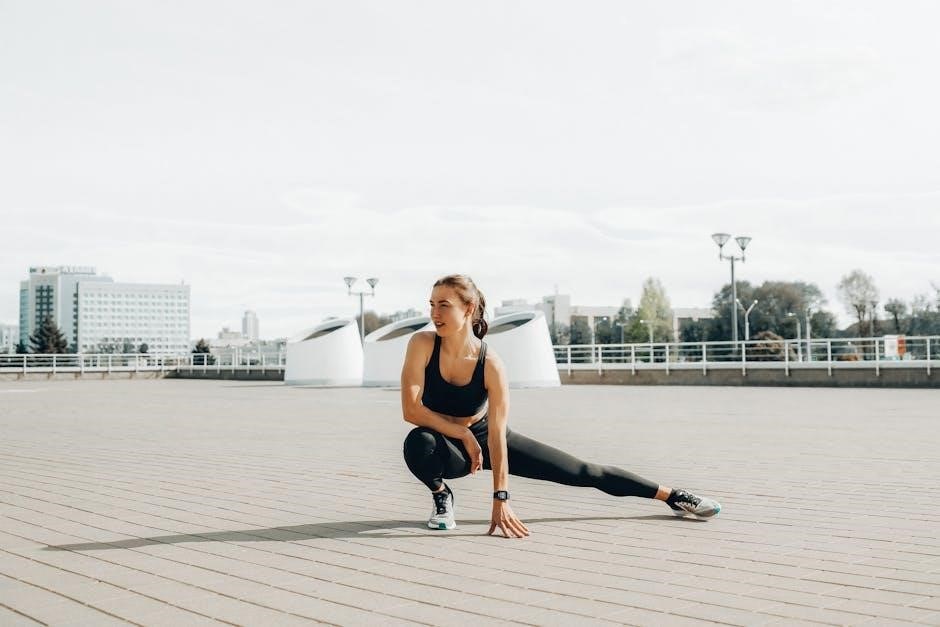
Stretching and Flexibility Routine
Stretching improves flexibility, reduces stiffness, and promotes healing․ Focus on hamstrings, calves, hip flexors, and IT band․ Consistent effort and proper technique are essential to prevent further injury․
5․1 Hamstring and Calf Stretching Exercises
Hamstring and calf stretching is crucial for improving flexibility and reducing tension that may contribute to quadriceps tendonitis․ Standing hamstring stretches involve bending forward at the hips with knees straight, holding for 20-30 seconds․ Seated calf stretches, using a towel or strap, target the gastrocnemius and soleus muscles․ Calf wall stretches, with one leg back and heel on the ground, can also be effective․ These exercises should be performed gently to avoid pain, ideally 2-3 times daily․ Incorporating dynamic stretches, such as leg swings and high knees, during warm-ups can further enhance flexibility․ Consistency is key to maintaining range of motion and supporting tendon recovery․ Proper technique ensures safety and effectiveness, preventing overstretching or injury․
5․2 Hip Flexor and IT Band Stretching
Hip flexor and IT band stretching is essential for addressing tightness that can contribute to quadriceps tendonitis․ The kneeling hip flexor stretch targets the iliopsoas muscle, while the standing IT band stretch focuses on the iliotibial tract․ Both exercises help reduce tension in the hip and knee regions․ Dynamic stretches, such as lunges and leg swings, can also improve flexibility․ Performing these stretches 2-3 times daily, with 20-30 second holds, promotes long-term flexibility․ Proper form is crucial to avoid strain, and mild discomfort is normal during stretching․ Regular practice helps maintain balanced muscle tension, supporting overall recovery and reducing the risk of recurrence․ These exercises complement other stretching routines, ensuring comprehensive lower limb flexibility․
5․3 Dynamic Stretching for Warm-Up and Cool-Down
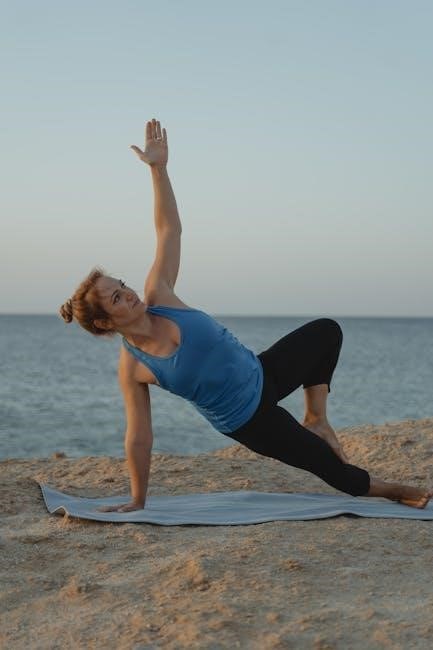
Dynamic stretching is a key component of warm-up and cool-down routines for quadriceps tendonitis․ It involves active movements that prepare muscles for exercise and aid in recovery․ Examples include high knees, lunges, and leg swings, which target the quadriceps, hamstrings, and hip flexors․ These exercises improve blood flow, reduce muscle stiffness, and enhance flexibility without the risk of overstretching․ During warm-ups, dynamic stretches activate the muscles, lowering injury risk․ Post-workout, they help flush out lactic acid and promote relaxation; Incorporating dynamic stretching into daily routines supports recovery, prevents muscle imbalances, and enhances overall mobility, making it a vital part of managing quadriceps tendonitis effectively․

Rehabilitation Programs and Progression
Rehabilitation programs for quadriceps tendonitis involve structured, progressive exercises tailored to individual needs, focusing on strength, flexibility, and functional recovery to ensure safe and effective progression․
6․1 Structured Home Exercise Programs
A well-designed home exercise program is crucial for managing quadriceps tendonitis․ It typically includes isometric exercises, gentle stretching, and strengthening activities tailored to the individual’s current phase of recovery․ These programs are structured to promote gradual progression without overloading the tendon․ Users are often provided with clear instructions, including sets, repetitions, and frequency, to ensure consistency․ Examples of exercises include straight leg raises, heel slides, and low-resistance band work․ The program should also incorporate proper warm-up and cool-down routines to enhance safety and effectiveness․ Regular monitoring and adjustments by a healthcare professional are essential to avoid plateaus or recurrence of symptoms․ Consistency in following the structured plan is key to achieving long-term recovery and functional improvement․
6․2 Graded Exercise Approach for Safe Progression
A graded exercise approach is essential for safely progressing with quadriceps tendonitis exercises․ This method involves gradually increasing the intensity of workouts to allow the tendon to heal and strengthen without overloading it․ Initially, exercises focus on pain management and basic mobility, such as isometric exercises like quadriceps sets and straight leg raises․ As symptoms improve, resistance can be introduced using bands or light weights to build strength․ Stretching exercises for hamstrings, hip flexors, and calves are also incorporated to improve flexibility․ Progression is based on symptom response, ensuring that exercises remain pain-free․ Monitoring by a healthcare professional helps adjust the program to prevent overexertion․ This structured approach minimizes the risk of recurrence and promotes long-term recovery․
6․3 Monitoring and Adjusting the Rehabilitation Plan
Monitoring and adjusting the rehabilitation plan is crucial for ensuring effective and safe recovery from quadriceps tendonitis․ Regular assessments of pain levels, strength, and functional ability help track progress․ If exercises cause increased pain or discomfort, they should be modified or avoided․ Progressions, such as increasing resistance or range of motion, are made only when the individual demonstrates improved symptoms and strength․ A healthcare professional or physical therapist can provide guidance on necessary adjustments․ Patient feedback is vital for tailoring the program to individual needs․ Adjustments may involve changing exercise intensity, frequency, or type to avoid plateaus or overloading the tendon․ This dynamic approach ensures the rehabilitation plan remains effective and aligned with recovery goals․

Preventative Measures and Long-Term Care
Preventative measures, such as strengthening exercises, proper footwear, and activity modification, are essential for long-term care and reducing the risk of quadriceps tendonitis recurrence․
7․1 Strengthening Hip and Core Muscles
Strengthening the hip and core muscles is crucial for preventing quadriceps tendonitis and improving overall lower limb stability․ Weakness in these areas can lead to poor movement patterns, increasing stress on the quadriceps tendon․ Exercises such as glute bridges, side-lying leg lifts, and planks target the glutes and core, enhancing their endurance and strength․ Incorporating these into a routine helps stabilize the knee joint and reduces the risk of overuse injuries․ Consistency is key, as progressive overload ensures continued muscle development․ Proper form and gradual intensity adjustments are essential to avoid exacerbating existing conditions․ Regular core and hip strengthening can significantly improve long-term outcomes and prevent recurrence of quadriceps tendonitis․
7․2 Proper Footwear and Training Techniques
Proper footwear and training techniques play a vital role in managing and preventing quadriceps tendonitis․ Wearing shoes with adequate cushioning, arch support, and stability reduces stress on the knee joint․ Avoiding worn-out footwear and opting for activity-specific shoes can minimize repetitive strain․ Training techniques should emphasize proper form, especially during squats, lunges, and jumps, to avoid placing excessive stress on the quadriceps tendon․ Incorporating a gradual progression of intensity and volume in workouts helps prevent overuse injuries․ Ensuring a proper warm-up and cool-down routine further protects the tendon from sudden strain․ By combining appropriate footwear with mindful training practices, individuals can significantly reduce the risk of quadriceps tendonitis and support long-term recovery․
7․3 Activity Modification to Prevent Recurrence
Activity modification is crucial to prevent the recurrence of quadriceps tendonitis․ Reducing high-impact activities and avoiding repetitive stress on the knee joint can significantly lower the risk of injury․ Incorporating low-impact exercises, such as swimming or cycling, helps maintain fitness without overloading the tendon․ Gradually increasing activity intensity and volume allows the tendon to adapt, reducing the likelihood of overuse injuries․ Proper warm-up and cool-down routines, along with consistent stretching and strengthening exercises, further protect the tendon․ Listening to your body and avoiding movements that cause pain are essential․ Consulting a healthcare professional to tailor activity modifications to individual needs ensures a safe and effective approach to preventing recurrence and maintaining long-term tendon health․

Downloadable Resources
Access comprehensive guides, including a free PDF on quadriceps tendonitis exercises, printable workout sheets, and video tutorials for proper form and progression tracking․
8․1 Free PDF Guide to Quadriceps Tendonitis Exercises
Download a comprehensive free PDF guide tailored for managing quadriceps tendonitis․ This detailed resource outlines a structured exercise program, including step-by-step instructions, illustrations, and progression plans․ Perfect for both patients and physical therapists, the guide covers isometric exercises, strengthening routines, and flexibility stretches․ It emphasizes proper form to avoid exacerbating the injury․ The PDF is organized into sections, making it easy to follow during recovery․ Whether you’re in the early stages of healing or advancing to functional training, this guide provides a clear roadmap․ It also includes tips for maintaining motivation and tracking progress․ Accessible anytime, this downloadable resource is a valuable tool for effective recovery from quadriceps tendonitis․ Consistency and adherence to the exercises are key to achieving long-term results․
8․2 Printable Workout Sheets and Progress Trackers
Stay organized and motivated with printable workout sheets designed for quadriceps tendonitis recovery․ These sheets provide structured exercise schedules, space for logging daily progress, and reminders to track improvements․ They include visual guides for proper form and repetition counts, ensuring consistency and safety․ Progress trackers help monitor strength gains, flexibility, and pain levels over time․ Customize the sheets to fit individual goals and rehabilitation phases․ Printable formats make it easy to carry them to physical therapy sessions or workouts․ These tools promote accountability and help maintain focus throughout the recovery journey․ By documenting progress, users can celebrate milestones and adjust routines as needed for optimal results․ Regular use enhances adherence to rehabilitation plans and supports long-term success․
8․3 Video Tutorials for Proper Exercise Form
Enhance your recovery journey with video tutorials designed to guide you through proper exercise form for quadriceps tendonitis․ These tutorials provide clear, step-by-step demonstrations of essential exercises, ensuring you perform movements safely and effectively․ From straight leg raises to heel slides and isometric holds, the videos cover a range of techniques tailored to strengthen the quadriceps and promote healing․ Accessible via the downloadable PDF guide, these tutorials are perfect for home use or to share with your physical therapist․ They emphasize proper alignment, breathing, and pacing, helping you avoid common mistakes that could worsen symptoms․ By following the visual instructions, you can confidently execute exercises, fostering a faster and safer recovery․ This resource is invaluable for maintaining correct form and maximizing the benefits of your rehabilitation program․
